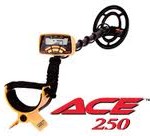WINDS, TIDES AND WEATHER-Wouldn’t it be great if the ocean suddenly receded several feet, leaving your favorite hunting beach high and dry? You could walk right out and recover lost treasure so much more easily. Well, the ocean does recede slightly every day during low tide. About twice a day a full tide cycle occurs-two high and two low tides. It’s low tide that interests the treasure hunter…when the water level has dropped, leaving more beach area exposed. A drop of only a few inches in tide level can take the ocean several yards farther out, especially on gently sloping swimming beaches. This exposes more beach to be searched and also makes more shallow surf area available.
You can learn when maximum low tides occur by reading tide tables in newspapers or obtaining them from scuba shops or fishing tackle stores. Weathermen on radio and television in coastal cities often report times of high and low tides. On some days, especially after a new or full moon, tides will be lower than usual. Take advantage of these opportunities.
The successful beach hunter begins working at least two hours before low die and continues that long after the ocean begins to rise. That’s four to six hours of improved hunting. Be alert to lowest of ebb tides when you can work beach areas not normally exposed. Timing search periods is important. I try to wok dry beaches during high tides and then follow the tide out, working a parallel path hugging the water’s edge. Each return path is nearly parallel to the preceding one. When the length of the paths is too long, each path will veer outward as the water recedes. Wide search coil sweeps can offset these veering paths.
Listen regularly to weather reports and forecasts to learn of prevailing winds. Strong offshore (outgoing) winds will lower the water level and reduce size and force of breakers. Such offshore winds also spread out sand at the water’s edge, reducing the amount that lies over the blanket of treasure. On the other hand, incoming wind and waves tend to pile sand up, causing it to increase in depth. Pay attention to winds and tides, especially during storms.
Weather is a contributing factor to tide levels, which can be dramatically altered by storms and high winds. A big blow moving in from sea may raise normal tides by several feet. When this occurs, wave action can become so violent that it is impossible and dangerous to hunt-even far up on the beach. But, the stage is set, and you should hit the beach when calm returns.
Conversely, an outgoing storm can cause lower tides and a compression of wave heights. These conditions and the changes they cause is a continuing process that controls sand deposits on the beach and in shallow water.
Storms often transfer treasure from deep-water vaults to shallower locations. Plan a beach search immediately following a squall. If you are hardy enough, try working during the storm itself. It may be revealing, Indian John told me of working a Florida beach during a deluge. Suddenly, at water’s edge, a gully began forming before his eyes. As it grew deeper, he suddenly caught the unmistakable glint of treasure. I don’t know how much he took from that glory hole, but he smiles when he tells the story.
Always remember that extremes in weather, wind and tides can make unproductive beaches suddenly become productive. Storms play havoc with beach sands. Fast-running currents that drain a beach can wash deep gullies in the sand to bring you closer to the blanket of treasure.

